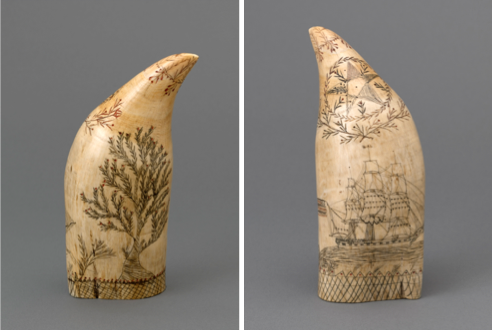At the peak of the golden age of whaling, 1825-1865, more than 700 whaling vessels sailed the seas. As a reference point, Herman Melville’s Moby Dick was published in 1851. Sailors didn’t hunt whales at night, sightings could be few and far between, and whaling voyages were often 3 years in length. In the downtime, and there was lots of it, many sailors occupied themselves with scrimshaw, and a delicately lined and boldly imagined example is in our collection.
Scrimshaw is any decorative or functional carving on marine mammal ivory or bones—and in this case is an engraving on a whale tooth, most likely a sperm whale tooth. The process is as follows. Whale teeth are ridged, and first a smooth surface would need to be made through filing and sanding. Once prepared, the scrimshander (the term for one who makes scrimshaw) would carve images into the tooth with a jackknife, sail needle, awl, or other dentist like tools. To bring out the design afterwards, india ink or lampblack, soot mixed with oil, would be applied to the tooth and then wiped away, with the ink staying in the grooves. For reddish sepia tones, rust or tobacco juice was used.
The whale tooth in our collection is by an anonymous artist, not uncommon for scrimshaw, who appears to be strongly concerned with arriving home safely!
This artist, most likely a sailor, incorporated many design elements found in scrimshaw from this period—the ship, border elements, nature, and nautical symbols, and used both red and black coloring. On the front of the tooth, we see the starboard broadside of the ship (a true ship because it has three masts that are square rigged, the fictional Pequod on which Captain Ahab sailed was a bark). This is important, because in some cases, depictions of whaling vessels on scrimshaw are the only visual record of a specific boat’s design. Also, an American flag is flying astern, aside from whaling signals, flags are typically only flown on homeward bound vessels. Above the ship is a 5-pointed nautical star, surrounded by a wreath made of what looks like branches from the flowering or fruiting tree on the back of this tooth, which brings in the red coloration as well. An image of the nautical star, or North Star, symbolically meant that the sailor could always navigate and find their way home. Additionally, the land on the verso with the tree that provided the wreath, and the mysterious house under the sea all promote this idea of getting home to land—something that was not in Captain Ahab’s destiny.
References
Malay, Richard C., Graven by the Fishermen Themselves: Scrimshaw in Mystic Seaport Museum (Mystic Seaport Museum, 1983),
Frederick Myrick of Nantucket: Physical Characteristics of the Scrimshaw by Donald E. Ridley, Janet West; with additional contributions by Desmond T. Liddy and Judith N. Lund ; and with research and editorial contributions by Paul E. Vardeman Jr., and Stuart M. Frank. KWM Monograph Series #14. 2000.
“Rigging of American Sailing Vessels”, Peabody Museum, http://www.pem.org/sites/archives/guides/rigs.htm
